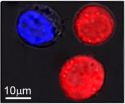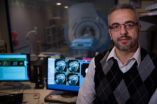(Press-News.org) Stanford, CA — Plants grow upward from a tip of undifferentiated tissue called the shoot apical meristem. As the tip extends, stem cells at the center of the meristem divide and increase in numbers. But the cells on the periphery differentiate to form plant organs, such as leaves and flowers. In between these two layers, a group of boundary cells go into a quiescent state and form a barrier that not only separates stem cells from differentiating cells, but eventually forms the borders that separate the plant's organs.
Because each plant's form and shape is determined by organ formation and organ boundary creation, elucidating the underlying mechanisms that govern these functions could help scientists design the architecture of crop plants to better capture light and ultimately produce more crop yield with less input. New research from two teams led by Carnegie's Zhiyong Wang and Kathryn Barton focuses on the role of the crucial plant hormone brassinosteroid in the creation of plant-shoot architecture. Their work is published by Proceedings of the National Academy of Sciences during the week of December 3.
Like all organisms, plant growth and development is regulated by internally produced chemical signals, including hormones like brassinosteroid, which is found throughout the plant kingdom. The brassinosteroid signaling pathway is involved in regulating more than 1,000 plant genes. Mutant plants that are deficient in brassinosteroid that are grown in the dark show features of plants grown in the light. They also have defects at many phases of the plant life cycle, including reduced seed germination, dwarfism, and sterility.
The new study lead by Wang and Barton uncovered yet another role of brassinosteroid: the formation of boundaries between organs. Plants made hypersensitive to brassinosteroid displayed fused organs.
The team included lead author's Carnegie's Joshua Gendron and Jiang-Shu Liu, as well as Min Fan, Mingyi Bai, and Stephan Wenkel, from Carnegie, and Patricia Springer from the University of California Riverside.
Their investigations showed that activation of the brassinosteroid pathway represses a group of genes called the cup-shaped cotyledon, or CUC family, which is responsible for organ boundary formation. Using sophisticated techniques the team demonstrated that the protein in the brassinosteroid pathway that is responsible for binding to DNA and, in this case, for inhibiting CUC genes, is present at high levels in the meristem's undifferentiated stem cells and developing organ primordia, but very low in the boundary cells, suggesting that different levels of brassinosteroid activity contribute to the opposite growth behavior of these three types of cells.
"This work links the plant steroids to growth and development, organ boundary development, providing a link between the physiology of the plant and its architectural design," Wang and Barton said.
###
This research was supported by the National Institutes of Health.
The Carnegie Institution for Science is a private, nonprofit organization headquartered in Washington, D.C., with six research departments throughout the U.S. Since its founding in 1902, the Carnegie Institution has been a pioneering force in basic scientific research. Carnegie scientists are leaders in plant biology, developmental biology, astronomy, materials science, global ecology, and Earth and planetary science.
Plant organ development breakthrough
2012-12-04
ELSE PRESS RELEASES FROM THIS DATE:
Russian Far East holds seismic hazards that could threaten Pacific Basin
2012-12-04
For decades, a source of powerful earthquakes and volcanic activity on the Pacific Rim was shrouded in secrecy, as the Soviet government kept outsiders away from what is now referred to as the Russian Far East.
But research in the last 20 years has shown that the Kamchatka Peninsula and Kuril Islands are a seismic and volcanic hotbed, with a potential to trigger tsunamis that pose a risk to the rest of the Pacific Basin.
A magnitude 9 earthquake in that region in 1952 caused significant damage elsewhere on the Pacific Rim, and even less-powerful quakes have had effects ...
Study spells out hat trick for making hockey safer
2012-12-04
TORONTO, Dec. 3, 2012—Mandatory rules such as restricting body checking can limit aggression and reduce injuries in ice hockey, making the game safer for young people, a new study has found.
Rule changes could be incorporated into existing programs that reward sportsmanship and combined with educational and other strategies to reduce hockey injuries, according to researchers at St. Michael's Hospital.
The need to address the issue is critical, said Dr. Michael Cusimano, a neurosurgeon. Brain injuries such as concussions frequently result from legal or illegal aggressive ...
Children with autism arrive at emergency room for psychiatric crisis 9 times more than peers
2012-12-04
BALTIMORE, Md. (December 3, 2012) – In the first study to compare mental health-related emergency department (ED) visits between children with and without autism spectrum disorders (ASD), researchers found that ED visits are nine times more likely to be for psychiatric reasons if a child has an ASD diagnosis. Published in the journal Pediatric Emergency Care (Epub ahead of print), the study found externalizing symptoms, such as severe behaviors tied to aggression, were the leading cause of ED visits among children with ASD. Importantly, the likelihood of a psychiatric ED ...
Curiosity shakes, bakes, and tastes Mars with SAM
2012-12-04
NASA's Curiosity rover analyzed its first solid sample of Mars in Nov. with a variety of instruments, including the Sample Analysis at Mars (SAM) instrument suite. Developed at NASA's Goddard Space Flight Center in Greenbelt, Md., SAM is a portable chemistry lab tucked inside the Curiosity rover. SAM examines the chemistry of samples it ingests, checking particularly for chemistry relevant to whether an environment can support or could have supported life.
The sample of Martian soil came from the patch of windblown material called "Rocknest," which had provided a sample ...
Alzheimer's researcher reveals a protein's dual destructiveness – and therapeutic potential
2012-12-04
A scientist at the University of British Columbia and Vancouver Coastal Health has identified the molecule that controls a scissor-like protein responsible for the production of plaques – the telltale sign of Alzheimer's disease (AD).
The molecule, known as GSK3-beta, activates a gene that creates a protein, called BACE1. When BACE1 cuts another protein, called APP, the resulting fragment – known as amyloid beta – forms tiny fibers that clump together into plaques in the brain, eventually killing neural cells.
Using an animal model, Dr. Weihong Song, Canada Research ...
Search for life suggests solar systems more habitable than ours
2012-12-04
SAN FRANCISCO—Scattered around the Milky Way are stars that resemble our own sun—but a new study is finding that any planets orbiting those stars may very well be hotter and more dynamic than Earth.
That's because the interiors of any terrestrial planets in these systems are likely warmer than Earth—up to 25 percent warmer, which would make them more geologically active and more likely to retain enough liquid water to support life, at least in its microbial form.
The preliminary finding comes from geologists and astronomers at Ohio State University who have teamed up ...
DNA analysis of microbes in a fracking site yields surprises
2012-12-04
SAN FRANCISCO—Researchers have made a genetic analysis of the microbes living deep inside a deposit of Marcellus Shale at a hydraulic fracturing, or "fracking," site, and uncovered some surprises.
They expected to find many tough microbes suited to extreme environments, such as those that derive from archaea, a domain of single-celled species sometimes found in high-salt environments, volcanoes, or hot springs. Instead, they found very few genetic biomarkers for archaea, and many more for species that derive from bacteria.
They also found that the populations of microbes ...
Multitasking plasmonic nanobubbles kill some cells, modify others
2012-12-04
HOUSTON – (Dec. 3, 2012) – Researchers at Rice University have found a way to kill some diseased cells and treat others in the same sample at the same time. The process activated by a pulse of laser light leaves neighboring healthy cells untouched.
The unique use for tunable plasmonic nanobubbles developed in the Rice lab of Dmitri Lapotko shows promise to replace several difficult processes now used to treat cancer patients, among others, with a fast, simple, multifunctional procedure.
The research is the focus of a paper published online this week by the American ...
Listen up, doc: Empathy raises patients' pain tolerance
2012-12-04
A doctor-patient relationship built on trust and empathy doesn't just put patients at ease – it actually changes the brain's response to stress and increases pain tolerance, according to new findings from a Michigan State University research team.
Medical researchers have shown in recent studies that doctors who listen carefully have happier patients with better health outcomes, but the underlying mechanism was unknown, said Issidoros Sarinopoulos, professor of radiology at MSU.
"This is the first study that has looked at the patient-centered relationship from a neurobiological ...
Women with sleep apnea have higher degree of brain damage than men, UCLA study shows
2012-12-04
Women suffering from sleep apnea have, on the whole, a higher degree of brain damage than men with the disorder, according to a first-of-its-kind study conducted by researchers at the UCLA School of Nursing. The findings are reported in the December issue of the peer-reviewed journal SLEEP.
Obstructive sleep apnea is a serious disorder that occurs when a person's breathing is repeatedly interrupted during sleep, sometimes hundreds of times. Each time, the oxygen level in the blood drops, eventually resulting in damage to many cells in the body. If left untreated, it ...


